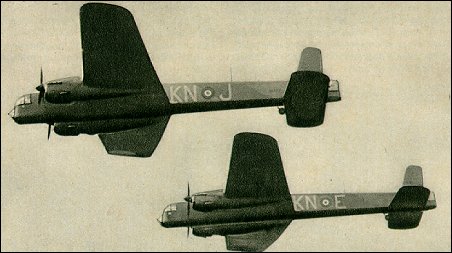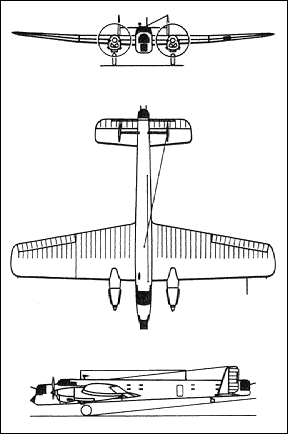|
| Most extensively built of all Armstrong Whitworth aircraft was the Whitley heavy bomber, designed to meet the British Air Ministry specification B.3/34. More than 1,800 were produced. Selected for production off the drawing board in 1935 the prototype flew for the first time on 17 March 1936. The second prototype and 34 Mk I production aircraft which followed were all powered by two 592.5kW Armstrong Siddeley Tiger IX radial engines. Mk IV, V and VII Whitleys, which followed later, had Rolls-Royce Merlin engines - these conferring considerably improved performance.
Whitleys began to enter RAF service in the early months of 1937 and by the outbreak of war in 1939 were wellestablished in the bomber squadrons. Being slower than the contemporary Handley Page Hampden and Vickers Wellington they were classed as night bombers. They were a vital component of Bomber Command operations until their withdrawal from front-line service in 1941. Achieving some of the major milestones of the war, the Whitley was responsible for the first widespread leaflet raids over Germany, in September 1939; the first bombing raid on Germany, in May 1940; the first bombing raid on Italy, in June 1940; and the first paratroop operation over Southern Italy, in February 1941. After its withdrawal from front-line service with Bomber Command the Whitley was converted for use as a general reconnaissance bomber and put into service by Coastal Command. In another converted form it was used to train the first British airborne troops and to take them into action for the first time, in a flight from England to Southern Italy. At the end of the war the type was still in service for training and other miscellaneous duties.

| CREW | 4-6 |
| ENGINE | 2 x RR "Merlin X", 840kW |
| WEIGHTS |
| Take-off weight | 12800 kg | 28219 lb |
| Empty weight | 8770 kg | 19335 lb |
| DIMENSIONS |
| Wingspan | 25.6 m | 84 ft 0 in |
| Length | 21.5 m | 71 ft 6 in |
| Height | 4.6 m | 15 ft 1 in |
| Wing area | 114.4 m2 | 1231.39 sq ft |
| PERFORMANCE |
| Max. speed | 357 km/h | 222 mph |
| Cruise speed | 297 km/h | 185 mph |
| Ceiling | 5360 m | 17600 ft |
| Range w/max.fuel | 2600 km | 1616 miles |
| Range w/max payload | 760 km | 472 miles |
| ARMAMENT | 5 machine-guns, 3150kg of bombs |
| lxbfYeaa, e-mail, 14.03.2024 06:08 20 reply | | Keith Looseley, e-mail, 10.11.2022 17:06 Whitley para dropping. Does anyone know why in many photos they had the wheels down for this? In a few photos they don't. I understand aerodynamics, but not the intimate details of airflow under the Whitley fuselage. reply | | Tony Lloyd, e-mail, 04.09.2013 19:45 correction to message sent today. Read June 1940 not 1941 reply | | Tony Lloyd, e-mail, 04.09.2013 19:22 A squadron of Whitley bombers flew from Scampton in 1941 refuelling and arming up in Jersey's (just commissioned) airport and a few weeks before the Germans occupied the Island. With the purpose of bombing Fiat and other prominent arms manufacturers in Italy, does anyone know the mark of aircraft and or the power plants installed therein?? This incident is little researched so any other 'gen' would be welcome, particularly photographs.. reply | |
| | vera, e-mail, 10.03.2013 01:52 Hi, could anyone tell me how the airoplane the 'Whitley" got it's name? Thank you. reply | | VinceReeves, 05.03.2013 23:07 A plane that did all that it was required to do perfectly well, except perhaps in the maritime role, where it was overloaded with various radars.
It shows the virtue of having competent, useful aircraft available in quantity here and now, rather than aeronautically sublime wonder-weapons arriving in the distant future. reply | | j.l.Muir, e-mail, 21.02.2013 00:20 While I have no questions about this aircraft, my step children, whose surname is Whitley, were quite tickled to have a famous aircraft that shared their name. It was a great pleasure to me to me able to find a picture and history to go with it as well.....thanks reply | | Steve Parshall, e-mail, 24.05.2012 09:43 According to the "Database" feature in the May Issue of Aeroplane, John Lloyd, the Whitley's designer broke with the old Armstrong Whitworth tradition of tubular construction and devised a method that employed rolled sections, pressings, and corrugated sheets. Furthermore, the fuselage was monocoque in structure--a first in British heavy bomber construction. Lloyd was determined to make the Whitley as easy and quick to manufacture, so he decided to use as few component parts as possible--and those that were used were of "standard section." To circumvent the use of complex double curvature skin panels, Lloyd gave the Whitley's fuselage long, straight, and nearly-parallel side, which payed big dividends in reduced construction time.
In flight, the Whitley could fairly be described as idiosyncratic: individual aircraft often behaved in slightly different ways. However, it was a docile airplane--never malicious or unforgiving in the way it handled. Pilots often had the feeling they were never completely in control. They seem to agree that the Whitley "very rarely did exactly what it was told, but what it did do was carried out reasonably well and in comfort." reply | | cathy, e-mail, 04.02.2012 16:28 was the Whitley bomber built in Whitley? I know i may sound silly but... thank you. reply | | Phil Hawker, e-mail, 02.02.2012 22:08 My mother's cousin, Robert Edward Salisbury, served as a tail gunner on a Whitley of 58th Squadron (Linton on Ouse, Yorks.), which was shot down in 1940 over Holland by German fighter ace Paul Gildner. All of the crew were killed. He was aged only 18yrs. Does anyone have any info on this incident? I know that the wreckage and bodies, surrounded by German soldiers, were seen the next morning by a young Dutch boy who had crawled along a narrow ditch to view it, but that's all I know. reply | | Cliff Didsbury, e-mail, 18.01.2012 19:11 Hello, this is a shot in the dark.
My Uncle, Cyril Didsbury, was a Flight Sergeant Air Gunner in 296 Squadron. He was killed on 3rd April 1943 after he was thrown out of Whitley Bomber No. BD533 when it crash-landed on farmland in Wiltshire. He was killed instantly. The other 3 crew members survived.
If anyone has any info about this incident I would be very grateful for a response. reply | | Barry, 07.11.2011 13:36 The length of the Whitley was 69ft 3in up until the MkV which was 70ft 6in. The Whitley was very much a case of you have to play the hand of cards you are dealt. Along with the comments elsewhere on this page it must be remebered that 146 longer range GR VIII's were delivered to Coastal Command and the first U-Boat to be sunk by Coastal Command (U 206)was by a Whitley in Novenber 1941. reply | | beifan, 18.06.2011 11:47 Also leaflets he slept and forgot to drop. Though he got his pilot's license in the CAG, he ended up as a wireles op / gunner, poor sod. reply | | bombardier, e-mail, 25.05.2011 11:52 Slow but effective in it's designed role as a night bomber reply | |
| | Nonie Crete, e-mail, 11.03.2011 01:09 My father flew this aircraft and went down because of engine problems on the first day of the war dropping propaganda. He ended up meeting Hermann Goering because he was Canada - he went on to be in the Great Escape, Nonie reply | | amanda wright, e-mail, 15.12.2010 22:59 My great uncle Eric was shot down on September 7th 1941 over Germany. He was a rear gunner in a Whitley with 58 Squadron. Would love to hear from someone who may have known him?? reply |
| John Sykes, e-mail, 04.12.2010 21:12 My father, Eric Sykes, was a WOP /AG 1939-1941. We were living in Leeds, Yorkshire at that time. I'm trying to find out what squadron Dad flew with. He was medically discharged in 1941 after 3 crash landings. Would Disforth, Driffield or Topcliffe be possibilities? Any help or suggestions would be terrific. reply | | John Drew, e-mail, 07.11.2010 12:17 My cousin P /sgt John Evans was killed piloting a Whitley V EB339 whilst serving with 81 OTU at RAF Whitchurch Heath during November 1942. The aircraft was a total right off but can anyone tell me the identification code (aircraft markings) that 81 OTU were using during November 1942. Better still does anyone know or advise how I can get the specific identification markings for this particular Whitley EB339.
Regards .. John reply | | Jim Garrod, e-mail, 06.11.2010 19:53 My brother Bob was killed in a Whitley in September 1941. Crashed over Holland, and I know who shot him down. I have his letters home from Jan 1940, covering training, operations etc., almost to the last one. Also leaflets he slept and forgot to drop. Though he got his pilot's license in the CAG, he ended up as a wireles op / gunner, poor sod.
All this and more, with many reproductions and much graphic detail is in a book I wrote and published called Suffolkers een't silly. ISBN 1-873373-02-3
I'd be pleased to hear from anyone interested. Always wanted to stand in a tail gunner's turret as he had to, but without any shrapnel coming through the floor. Any ideas? reply | | Jack Enright, e-mail, 09.09.2010 06:27 To Leo Rudnicki
The Whitley flew nose down because the wing was set at a high angle of incidence to give good lift at slow speeds. Most other aircraft by then were fitted with flaps for this purpose, but the Whitley's designer had no experience of flaps. Later versions were fitted with flaps, but the wing incidence was not changed. As you suggested, adjusting the design to fly level would have reduced drag, and thus increased speed and range. Maybe this was never done because the gain was not considered worth the work involved. One big advantage of the wing was the very low stalling speed. I believe the Whitley could trundle into a landing at a measly 65 mph! Like the wartime Bedford 3 tonner, the Whitley was slow, and no beauty - but, like the Bedford, was reliable, a good load-hauler, and tough as old boots. reply |
|
Do you have any comments?
|
| 
COMPANY
PROFILE
All the World's Rotorcraft
|









20
reply